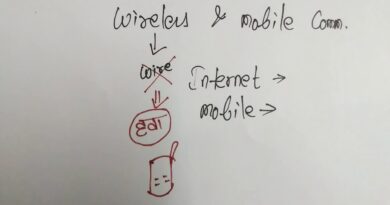Wireless and Mobile Communication: Wireless and Mobile Communication lecture in Hindi-Concept of 1G 2G 2.5G 3G 3.5G 3.75G 4G 5G
Wireless and Mobile Communication: Wireless and Mobile Communication lecture in Hindi-Concept of 1G 2G 2.5G 3G 3.5G 3.75G 4G 5G.
Contents [hide]
- 1 Wireless & Mobile Communication: Evolution from 1G to 5G
- 2 What is Wireless & Mobile Communication?
- 3 Evolution of Mobile Networks (1G to 5G)
- 4 1G (First Generation) – Analog Voice (1980s)
- 5 2G (Second Generation) – Digital Voice & SMS (1991-2000)
- 6 3G (Third Generation) – Internet & Multimedia (2001-2010)
- 7 4G (Fourth Generation) – High-Speed Broadband (2010-2020)
- 8 5G (Fifth Generation) – Ultra-Fast, Smart Connectivity (2020-Present)
- 9 Comparison of 1G to 5G
- 10 Future: 6G & Beyond!
- 11 Conclusion
Wireless & Mobile Communication: Evolution from 1G to 5G
Wireless communication has evolved significantly over the years, from basic analog voice calls (1G) to the ultra-fast and intelligent 5G networks of today. Understanding this evolution helps in grasping mobile technology advancements and their impact on daily life.
What is Wireless & Mobile Communication?
Wireless communication refers to the transfer of information without physical cables, using radio waves, microwaves, or infrared signals. Mobile communication allows wireless connectivity between users across different locations.
Evolution of Mobile Networks (1G to 5G)
1G (First Generation) – Analog Voice (1980s)
Technology: Analog radio signals (AMPS, NMT, TACS)
Speed: 2.4 Kbps (Very slow)
Features: Only voice calls (No SMS, No Internet)
Limitations: Poor sound quality, No security, Large mobile phones
2G (Second Generation) – Digital Voice & SMS (1991-2000)
Technology: GSM (Global System for Mobile), CDMA
Speed: Up to 64 Kbps
Features:
Digital voice calls
SMS & MMS
Basic internet via GPRS (2.5G) & EDGE (2.75G)
Limitations: Slow data speed, Limited multimedia
3G (Third Generation) – Internet & Multimedia (2001-2010)
Technology: UMTS, HSPA, WCDMA, CDMA2000
Speed: Up to 2 Mbps
Features:
Mobile Internet
Video calls
Email & Social Media
3.5G (HSPA) & 3.75G (HSPA+) improved speeds
Limitations: Expensive data plans, High battery consumption
4G (Fourth Generation) – High-Speed Broadband (2010-2020)
Technology: LTE (Long Term Evolution), WiMAX
Speed: Up to 1 Gbps
Features:
HD Video Streaming
Fast Browsing & Online Gaming
VoLTE (High-quality voice calls over LTE)
4G+ (LTE-Advanced) further improved speed
Limitations: High data usage, Requires modern devices
5G (Fifth Generation) – Ultra-Fast, Smart Connectivity (2020-Present)
Technology: mmWave, Massive MIMO, Beamforming
Speed: Up to 10 Gbps
Features:
Superfast Internet
Low Latency (~1ms)
IoT & Smart Cities
AR/VR, AI-powered services
Limitations: Expensive infrastructure, Limited coverage (initially)
Comparison of 1G to 5G
| Generation | Year | Speed | Key Features |
|---|---|---|---|
| 1G | 1980s | 2.4 Kbps | Analog voice calls |
| 2G | 1991 | 64 Kbps | Digital calls, SMS, MMS |
| 2.5G | Late 90s | 144 Kbps | GPRS (Basic internet) |
| 2.75G | 2000s | 384 Kbps | EDGE (Faster data) |
| 3G | 2001 | 2 Mbps | Mobile internet, Video calls |
| 3.5G | 2005 | 14 Mbps | HSPA, Streaming, Social Media |
| 3.75G | 2008 | 42 Mbps | HSPA+ (Enhanced internet) |
| 4G | 2010 | 100 Mbps – 1 Gbps | HD Streaming, VoLTE, Online gaming |
| 5G | 2020 | 10 Gbps | IoT, AI, Autonomous cars, Smart cities |
Future: 6G & Beyond!
Expected by 2030
Speeds up to 100 Gbps
AI-driven automation & Smart Everything!
Conclusion
From 1G to 5G, mobile networks have transformed the world, enabling faster communication, digital connectivity, and smart technology. The future of 6G will bring even more revolutionary advancements in AI, IoT, and automation!
Would you like more detailed explanations or examples on any specific generation?


